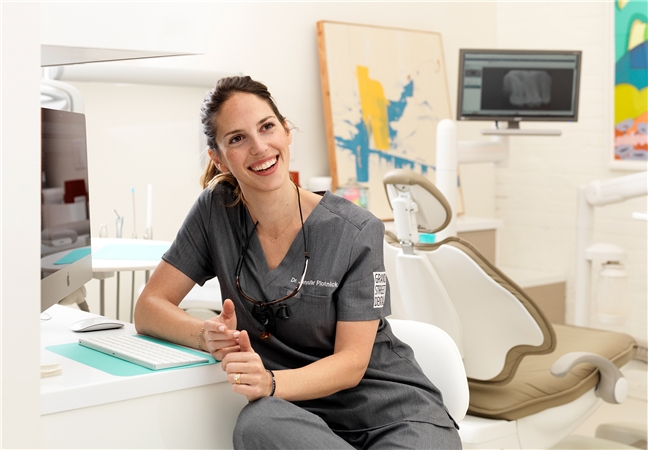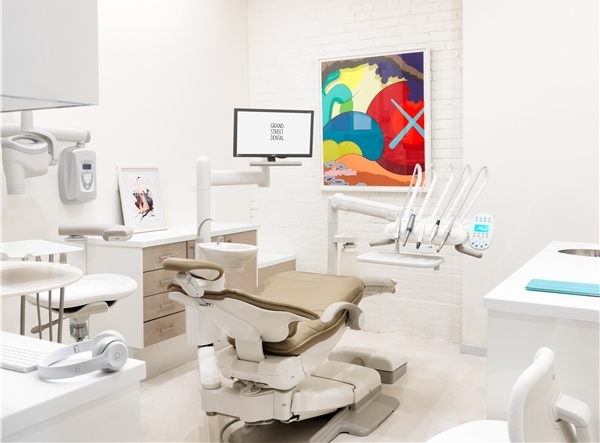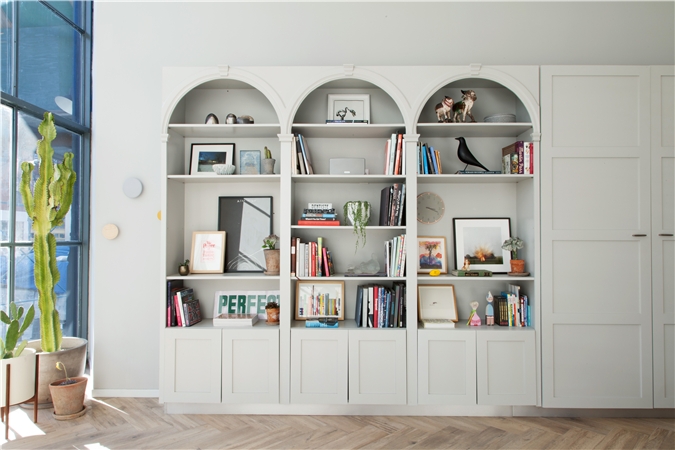Take a close look at your average dental practice and see if you can spot any kind of overall theme. It’s likely you’ll come away thinking everything looks clean and sterile, with the message being one of sanitation and professionalism. What you might not see are clues about the personality of the provider, even though the best doctor and patient relationships are built on humanizing both parties.
Grand Street Dental is an exception. The Brooklyn-based dental practice, which opened its doors in summer 2016, has become something of an anomaly in the field, with profiles in Forbes and New York Magazine marveling at its meticulously-designed office layout as well as their internet profile. Front-facing windows give off an art gallery feel; paintings, bookshelves, and a lack of generic brochures add to the cottage-type vibe; social media posts are original and irreverent, not stock-sourced. If this is a place to come for an occlusal adjustment, it also feels like being one live band removed from a coffee hangout.
“Every other industry has soared in terms of the user experience,” says Jennifer Plotnick, DMD, the owner and co-decorator (along with her photographer husband) of the space. “There’s been a flat feeling in medicine in general. I felt I could create something different in the world of dentistry that hasn’t been seen before.”
We asked Plotnick how she met her design goals, her unique approach to social media, and why adding a large dose of personality to your practice can not only draw attention but create the kind of customer satisfaction buzz that leads to a five-star reputation.
Grand Street Dental doesn’t feel like a typical dental practice. What was the motivation to try and carve out a different identity for your space?
I wanted to create a space and an environment that reflected me and my personal interests as well as be a space that I wanted to be in every day. I think that people are responding to the design but they’re also responding to the authenticity around it. Everything in medicine is upgraded and modern, but there’s not a lot of personality. Putting myself out there and sharing my interests lets people get an idea of me and see if I’m the right provider for them. It’s a win-win.
Photo courtesy of Grand Street Dental
A lot of that personality is on display on your various social media accounts, including Instagram and Facebook, where you show an off-duty side of yourself and your design influences. What makes that beneficial?
I’m hoping to attract like-minded people. Many of our patients find us on social media and I believe that this is because people do their research and would like to know a little bit about their provider before making an appointment. When you look at our Instagram page you can definitely get a good feel for what we’re about. They’ve seen the art we buy for the office, pictures of the staff and through all these posts they get to know us. So even before their first visit there’s already a notion for who we are. And if we are authentic to that then we’ve already created a level of trust. Plus, what better way to keep in touch with your patients than social media?
That’s a departure from the standard, which can be stock photos or pre-designed sites from marketing companies.
Definitely. I have a point of view and an aesthetic and an ability to create the content. There was no need to hire an outside party. We also wanted to be different. If I used the same people who designed and marketed for every doctor in New York City, chances are my practice would just blend into the background. Most other industries put a lot of effort into their branding and marketing and medical professionals have been slow to adapt. They shouldn’t be, because branding is just a way to show other people who you are.
But not necessarily by farming out the work?
Instead of going to a dental-specific design company, go to an actual designer, someone who can come up with unique branding. My husband and I did it ourselves, but we put a lot of time into it. Doing it right as opposed to using stock business cards or stock images adds so much value. It’s some of the best money you can spend.
People really seem struck by your Instagram images, which often use conceptual still life ideas like a bent fork for braces or an overripe banana to represent a dark-colored tooth. It’s a big departure from the generic images of perfect white teeth typically seen on dental feeds.
I think it’s another way of how I show my creativity and help engage an audience. I know I love a good ol’ retracted lip view of a before and after, but most of my patients don’t. It’s kinda scary looking! Perhaps if my patients were scrolling through the Invisalign section of my website that would be an appropriate place to show off my dental work, but Instagram is where I show the personal side. I wanted to show people that dentists are creative beings with superhero capes!
The other side of your social media puts an emphasis on your staff. Is that adding to a sense of pre-visit comfort for potential patients?
I’m going for a sense of community. I’m hoping to make lifers out of my staff. In many practices there’s a sense of transience, especially in New York City. My assistant Lisa was my very first dental assistant 10 years ago and Joanna was my first assistant in Manhattan after moving back from Canada 8 years ago! My hygienist Liza and I went to school in Montreal together and so did my oral surgeon, Stephanie! I want to show everyone how much I appreciate them! I think patients can certainly sense when you have a happy office and that instills an immense feeling of confidence.
If social media is your first impression, the second is the actual office, which is adorned with everything from cacti to original art. What do patients see when they first walk in, and what are you trying to communicate?
People are used to walking into a dimly lit waiting room void of personality. There will most likely be a TV and some out of date magazines with the inserts falling out. There is no TV at Grand Street Dental because a TV means you’re going to wait. Instead, there’s a space that people feel comfortable in. And it’s not just for them, it’s for me. I’m going to be spending the next 20-plus years there. I want to make sure it inspires me!
Photo courtesy of Grand Street Dental
There’s also real attention to details, which can sometimes get overlooked when practices think about designing—or re-designing—their space. Your pencils have a “don’t chew this” message, for example.
Paying attention to every detail is one of the reasons Grand Street may have made its mark early on. I spent four months just picking out the right shade of white for the wall paint. When we were designing the space, I sat everywhere a patient would sit and didn’t cut any corners on the patient experience. The music is current, There are no loose wires just hanging around. The walls are clean, and a lot of effort went into making the overall appearance seem effortless!
Your aesthetic has been big on art and design, which represents your interests. But it seems like it would be a mistake for a provider to just try and copy that approach without thinking about what makes them unique.
There are a lot of ways to be unconventional. Maybe you’re into skiing, or perhaps world travel, or something else. You can try and be design-oriented, but if it’s not authentically you, people will know. You won’t be able to talk to people about it, you won’t understand their references, and they’ll catch on. You need to find your own way.
Photo courtesy of Grand Street Dental
That rapport is obviously key to patient satisfaction. You have a stellar patient review profile on Zocdoc.com. Are reviews something you solicit, or run any kind of rewards program for?
I don’t ask patients for reviews. As soon as you ask one person, they’ll think the rest of your reviews were asked for. I would never offer any kind of reward, either. If they’re taken aback by the level of service, they’re going to want to tell their friends or share it in some way. Patients tend to become evangelistic about doctors they love. People are happy to share if they know their friend or family member is going to get treated really, really well. That’s the best marketing you can do.



